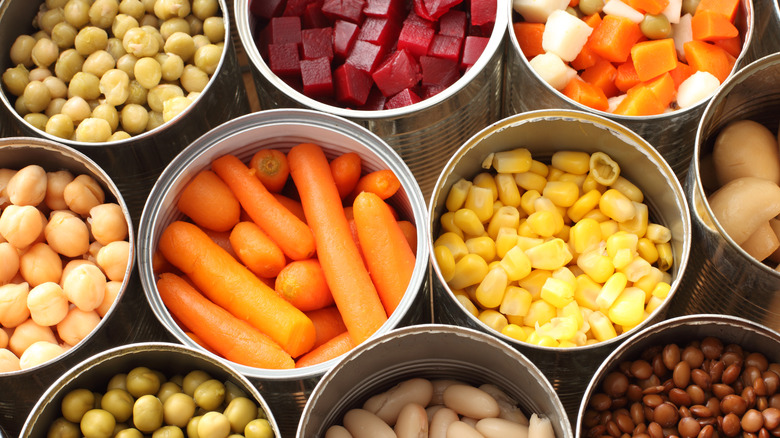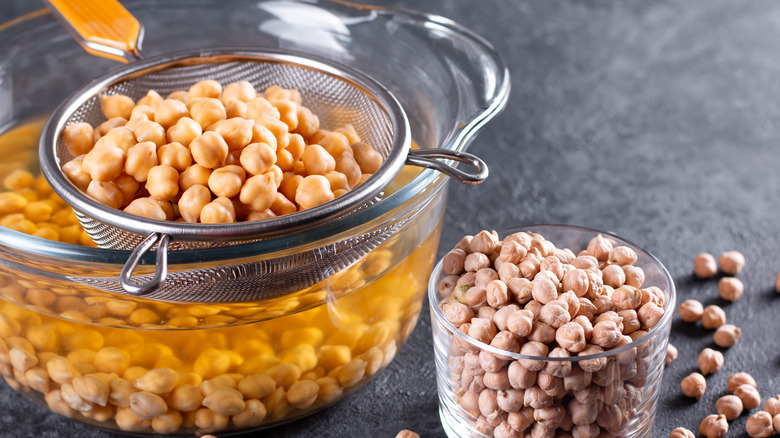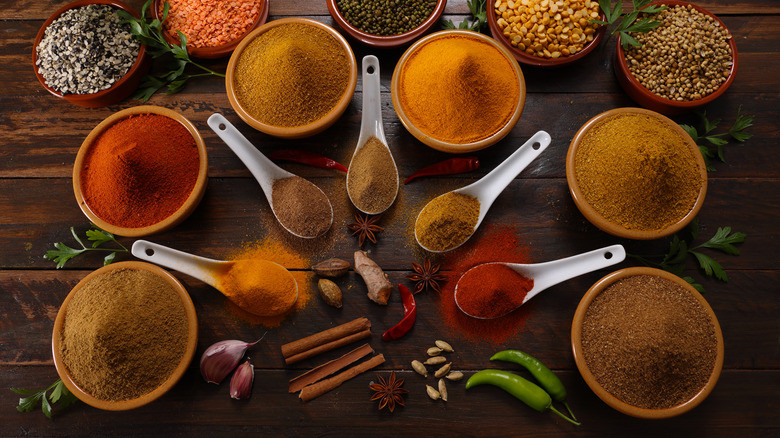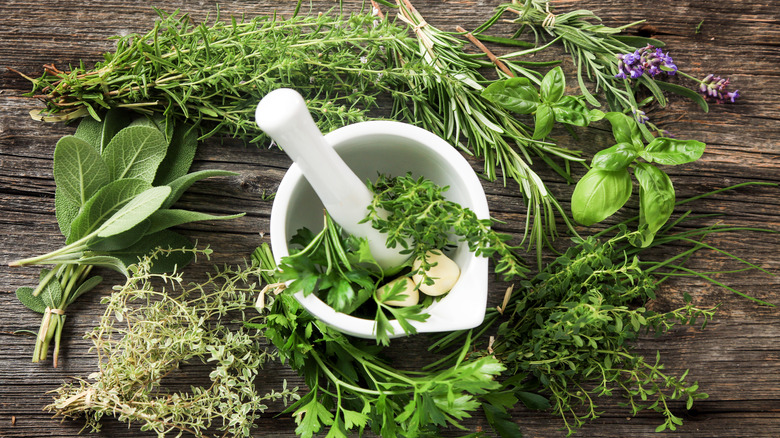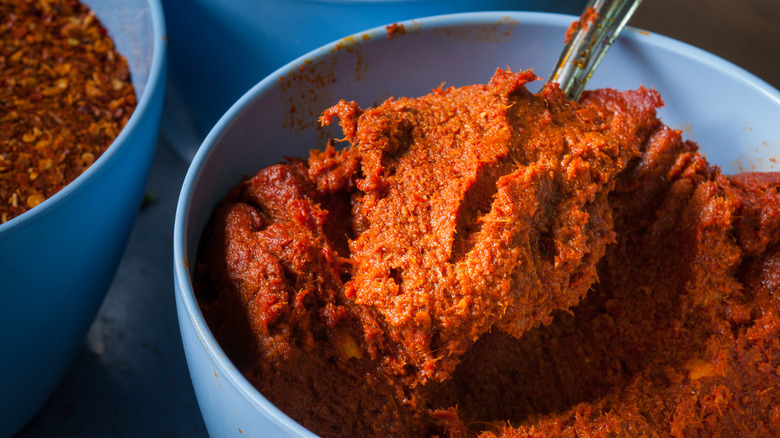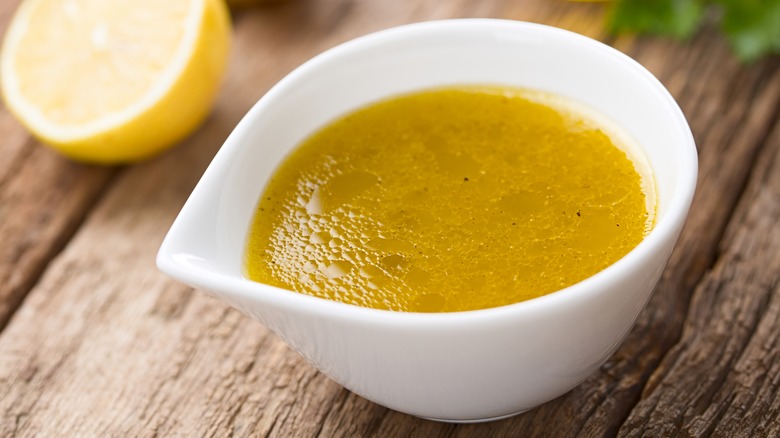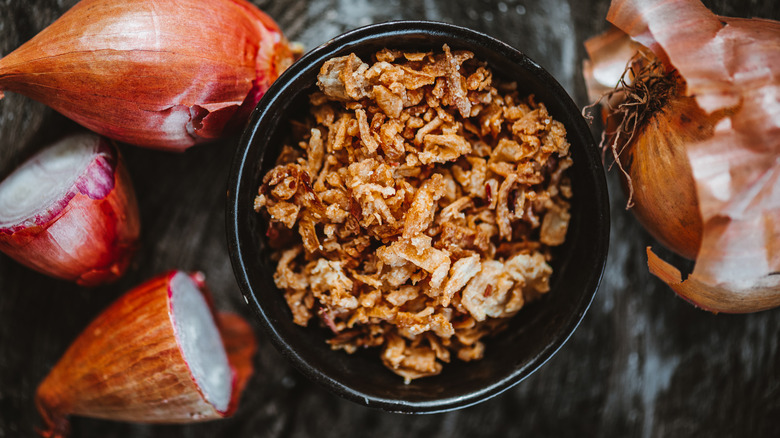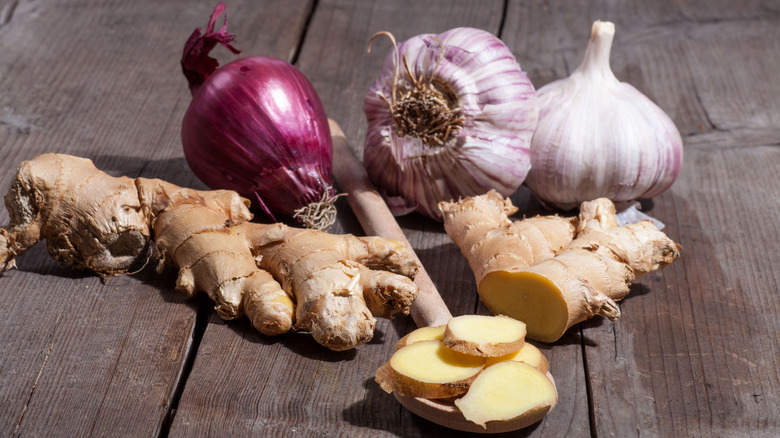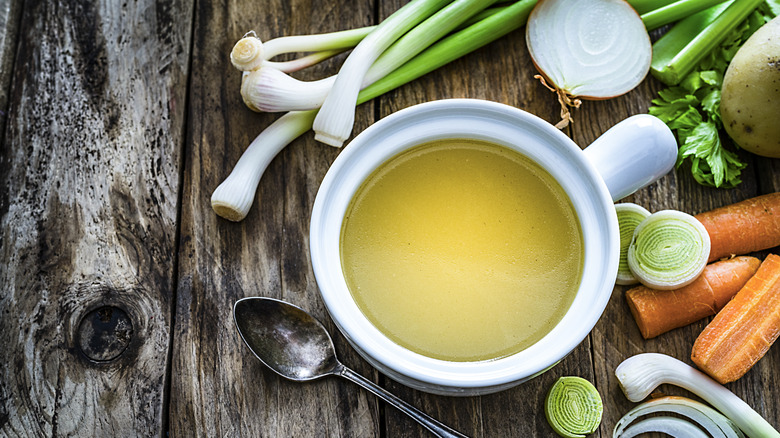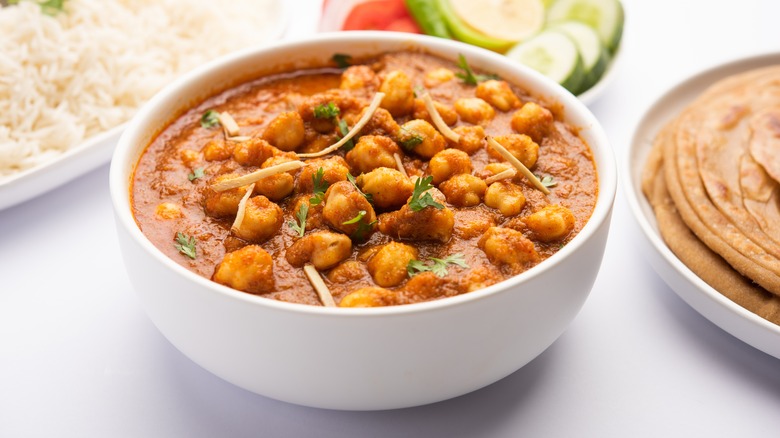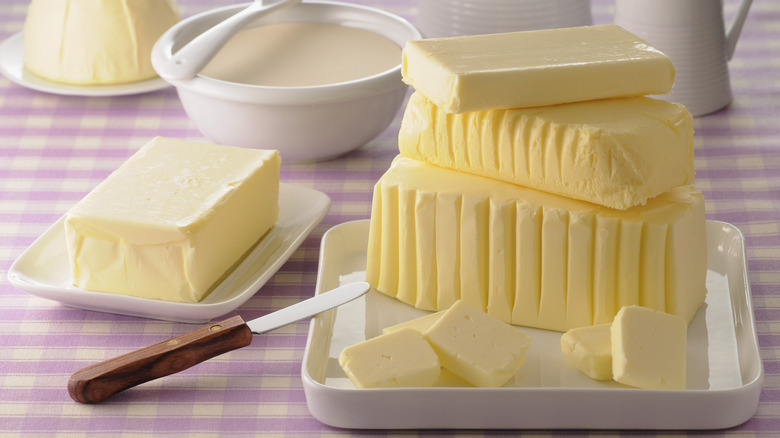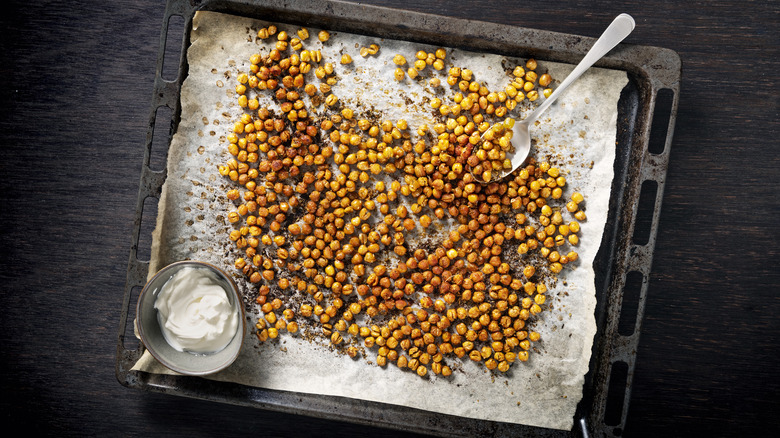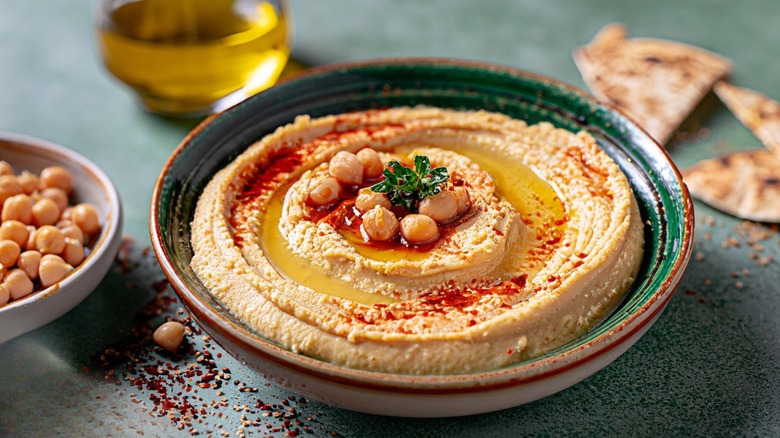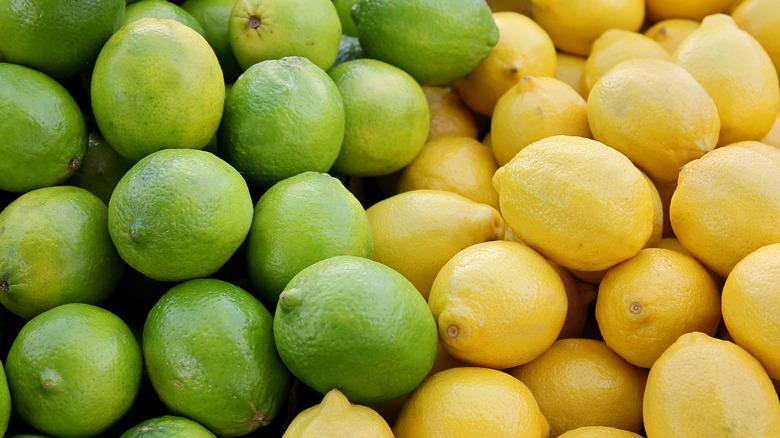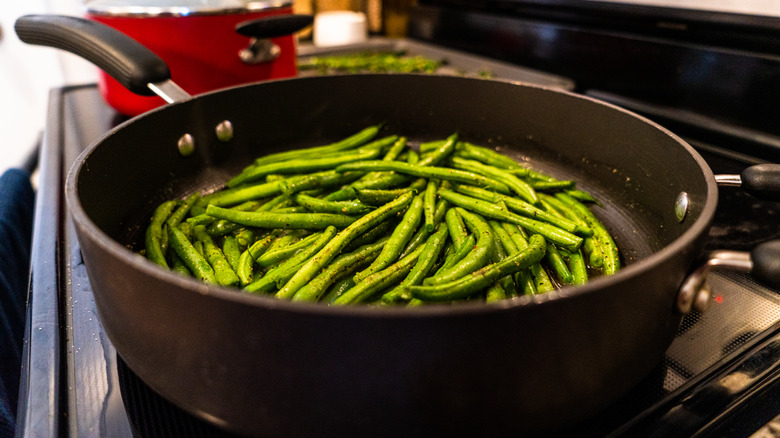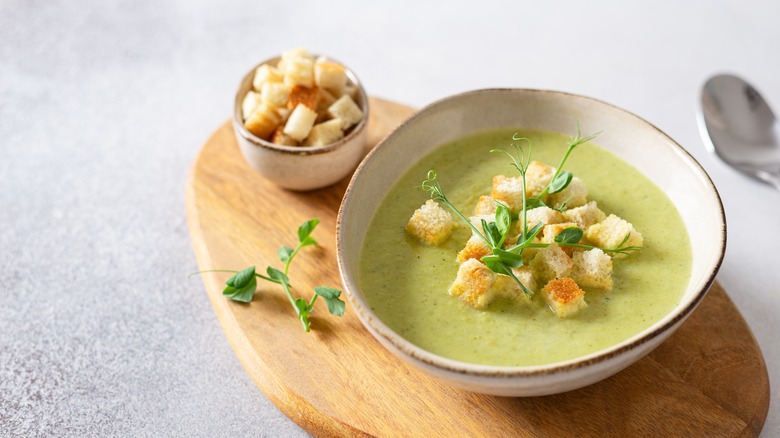15 Tips To Make Canned Food Taste Better
Canned food is practical. It can last in your pantry for years, so you have a stock of ingredients ready on lean weeks or when you simply don't fancy a trip to the store. However, it isn't exactly the most delicious or inspiring of foods. People don't wax lyrical about canned goods the way they might about a perfectly springy focaccia or plums straight from the icebox (so sweet, so cold). But, that doesn't mean you just have to grin and bear it. There are all kinds of ways to improve the taste of canned food.
There are easy options, such as rinsing them before use and adding herbs, spices, and other tasty seasonings. Plus, you might want to think about how you use your canned foods. For instance, canned green beans might be perfect in a green bean casserole for that nostalgic vibe, but they won't pair as well in a stir fry, where you want them to be crisp and fresh.
We have 15 tips to make canned food taste better. So, whether you're eating it to save money, for convenience, or because society as we know it is finally over and you're stuck in a bunker somewhere, you can make the most of your supplies.
1. Drain and rinse canned vegetables and beans
Have you ever noticed that canned beans and vegetables can taste a bit ... canned? Well, part of that is down to the canning liquid. There's nothing wrong with it and it's perfectly safe to consume, but it can impact the flavor of whatever dish you end up using it in. Luckily, there's a simple solution — drain and rinse canned vegetables and beans before cooking them.
The other reason why you should rinse your canned vegetables and beans is that some are packed in brine and rising them off will help to remove some of the excess sodium. This can keep dishes that feature canned vegetables from tasting overly salty.
All you need to do is dump your beans or vegetables into a colander and give them a quick rinse. However, if you're draining beans — especially chickpeas — you might want to save the liquid. It's known as aquafaba and it can be used as a replacement for egg whites in baked goods and other recipes. Once your canned goods are rinsed and drained, you can use them as usual.
2. Add dried herbs and spices
One of the most simple ways to improve the flavor of canned food is to add dried herbs and spices. Some canned food, such as beans and vegetables, obviously needs seasoning, and your spice rack is a great place to start. Even ready-made canned foods — like soup or chili — that are already seasoned lack the complexity of flavor of fresh ingredients and dishes made from scratch. But, with the right herbs and spices, you can easily transform these canned goods into delicious meals.
You can use standard ground spices, but if you really want to go all out, you can try whole spices. Grind them yourself, blend them into the dish at a later point, or simply leave them whole. But, what combinations of herbs and spices should you try? An Italian herb blend can bring a burst of Mediterranean flavor to canned tomatoes, beans, or vegetables. It's perfect for pasta dishes, soups, and stews. Or, if you want to spice things up a bit, a blend of chili powder, cumin, paprika, garlic powder, onion powder, and a pinch of cayenne pepper can turn a range of canned bean varieties or canned corn into a flavorful base for tacos, burritos, or nachos. There are so many combinations to try, so get experimenting.
3. Use fresh herbs
Fresh herbs elevate dishes — even if those dishes come from a can or heavily feature canned food. Okay, we get that if you have abundant fresh herbs on offer, you might not need to raid the back of your pantry for canned goods that need serious fancying up. That said, you might have an herb garden or just happen to have some herbs in your fridge, in which case, this tip is for you.
Fresh herbs, such as basil or oregano, are great for elevating canned spaghetti sauce. Or simmered with canned tomatoes, garlic, and onion to create your own spaghetti sauce from scratch. You can mix fresh parsley through a lackluster canned soup or improve canned chili or canned refried beans with some fresh cilantro. Think about the flavor profile of the canned food you're working with or the dish you want to make from it, and choose your herbs accordingly.
4. Consider ready-made spice pastes
You can elevate canned foods to new heights by making use of ready-made spice pastes. These pastes are incredibly convenient and can infuse your canned goods with complex flavors. These pastes are packed with a blend of aromatic herbs, spices, and other ingredients, making them a quick and easy way to add depth and richness to your dishes.
Indian curry pastes — such as Balti paste or korma paste — are popular, as are Thai curry pastes (both red and green), jerk seasoning paste, and harissa paste. But, basically any spice paste can bring a lot of flavor to your meal. Generally, these pastes are best when used to make a recipe from scratch using canned goods. For instance, some Balti paste, a can of tomatoes, and a can of chickpeas will make a delicious curry. However, you can use them to improve ready-made canned foods, such as soups or chili. Just be careful not to add too much of any pastes that contain salt.
5. Cover canned food with dressings
Want to add flavor, moisture, and texture to canned foods? Dressings might be what you need to help. They can coat or top foods to bring an extra layer of flavor. Depending on the food or what you're making with it, there are a range of dressing options to consider.
A simple vinaigrette can work wonders with canned beans to create a flavorful bean salad. There are mistakes you can make with vinaigrette, but it's generally a crowd-pleaser and fairly hard to completely mess up. You could also make a sour cream dressing and use it to top canned soup or canned chili — or you could mix it with canned black beans and corns as part of a burrito filling. Tahini dressing is another option, which adds a rich, nutty flavor to canned vegetables like chickpeas or lentils.
You can easily customize dressings to suit your preferences and create delicious dishes using canned ingredients. You might even find the ingredient you need to make some of these dressings in your pantry, which is great if you're trying to save money or avoid grocery shopping.
6. Mix in crispy ingredients for texture
Of course flavor is important when trying to improve your canned food, but it isn't the only factor. You should also look to texture. The problem with canned food is that it's been soaking in liquid for as many months as it's been on the grocery store shelves — and languishing in your kitchen cabinets. This means it can be on the soggy or mushy side.
Even when it isn't mushy, it's usually softer than many people like it. The noodles in that canned noodle soup will be far from al dente, while canned carrots will lack any degree of crunch. That's why we recommend adding some crispy ingredients to your meal to bring texture.
That green bean casserole could have breadcrumbs or crushed potato chips on top, you could add crispy onions on top of your noodle soup, or toast some seeds and use them in a canned bean or veggie salad. Anything that brings some crunch is perfect for adding texture to canned food.
7. Fry up some aromatics
Aromatics are ingredients that add flavor, fragrance, depth, and complexity to dishes. They typically include vegetables, herbs, and spices that release enticing aromas when cooked. Common aromatics include onions, garlic, leeks, ginger, lemongrass, celery, carrots, and fennel. Using aromatics can greatly enhance the flavor of canned food by infusing it with layers of savory, sweet, and herbaceous notes.
Sauté aromatics like onions, garlic, and celery in a bit of oil or butter until they become soft and translucent. This forms the flavorful base of your dish. You can then add canned ingredients like beans, tomatoes, or vegetables, and have this base give them a flavorful punch. You can also add extra cooked aromatics to canned soup, stew, or chili to improve the flavor.
It's a good idea to know some of the common aromatic bases used around the world. For instance, the Cajun holy trinity is onions, green bell peppers, and celery, while a French mirepoix is onions, carrots, celery, and sometimes leeks. By harnessing the natural flavors and aromas of these combinations of aromatics, you can make ordinary canned ingredients taste so much better.
8. Get extra flavor from veggie broth
A simple way to inject some extra flavor into your canned food is by adding some vegetable broth. Instead of cooking your canned vegetables or beans in water, simmer them in a bit of broth and they'll instantly be more flavorful. You can use homemade vegetable stock, bouillon cubes, ready-made broth, or instant powdered broth.
This method is best for canned ingredients rather than canned ready-made foods, such as soup. With ready-made foods, they usually already have the consistency you want from them, so adding in some broth is only going to make them watery. The exception to this is canned refried beans, which often come out of the can too thick and gloopy and can be improved by being thinned with broth. The other reason why adding broth to ready-made canned foods can be a problem is that broth is salty, and these foods usually already have enough salt. That said, the saltiness of broth benefits canned foods that are under-salted and tasteless.
9. Add beans and lentils earlier in the cooking process
Ever added canned beans to a recipe, only to find them disappointingly dry and chalky in the finished dish? Recipes that call for canned beans or lentils often instruct you to add them toward the end of the cooking process, just giving them enough time in the pot to heat through. The intention behind this is so they don't end up overcooked, but it often leaves you with the opposite problem: They end up undercooked and not quite soft enough. Luckily, there's a simple solution: Add beans and lentils earlier.
If you're making a soup or stew with beans or lentils, you'll usually find that you add other ingredients — such as canned tomatoes, stock, and fresh veggies — earlier in the process and simmer them for 20 to 30 minutes before adding the canned legumes. Instead of waiting this long, dump the beans or lentils in the pot earlier in the process and let them simmer away. This way, they'll end up perfectly tender and they'll also pick up more of the flavor from the dish.
You might be thinking, "Aren't canned beans already cooked enough?" Well, yes and no. They're cooked enough to taste alright and be safe to eat, but they're often not as soft or creamy as beans cooked from scratch due to shorter cooking times. There are exceptions, especially when using high-end canned beans, but they could usually do with extra cooking time to improve their texture.
10. Don't be afraid of butter and oil
Fat is a carrier of flavor. You might have heard this said before, but what it means is that certain flavors stick to fat molecules, which helps prolong the flavors in our mouths. Fat can help release and intensify the aromas of spices, herbs, and other aromatic ingredients. When these aromatic compounds are combined with fat during cooking, they become more pronounced and contribute to a more aromatic and flavorful dish. So, you shouldn't skimp on butter or oil when cooking with canned foods.
Butter, of course, has its own flavor and can make canned foods taste better just by cooking them in it. You could even brown the butter if you want to elevate its toasty notes. High-quality olive oil also tastes great and is good for cooking canned foods in or drizzling over finished dishes. However, even neutral oils can give you more flavor and better distribution of flavor when you cook aromatics in it or use it in a simple hack to bloom dried herbs and spices.
11. Roast canned beans
Looking for a new, more flavorful way to enjoy canned beans? Roasting them is one option. It can improve their flavor and texture, transforming them into tasty, toasty morsels. While chickpeas are a common choice for roasting, you can absolutely roast any type of canned bean. Cannellini beans, navy beans, and even black beans are great roasted.
Roasting canned beans caramelizes their natural sugars and creates a crispy outer layer, making them rich and nutty. The process also adds a crunch to canned beans. This exterior crispiness contrasts with their creamy interior. What's cool is that you can change up the flavor of roasted beans by seasoning them with your favorite herbs, spices, or seasonings before roasting. Popular options include garlic powder, cumin, paprika, chili powder, or dried herbs like rosemary or thyme. Experimenting with different seasonings allows you to create unique flavor combinations to suit your taste preferences.
You can eat roasted beans in various ways. They make a tasty snack on their own or you can eat them as part of a meal. They're great as a topping for salads, soups, or grain bowls, adding some texture.
12. Stick to recipes where a softer texture is an advantage
Canned foods often have a softer texture compared to their fresh counterparts due to the processing and canning methods involved. You're not going to find much snap or crunch in a can of food, and this can make people enjoy it less than they do fresh food. While this softer texture may not appeal to everyone, it can actually be an advantage in certain dishes where a softer consistency is what you want.
So, how should you use the soft texture to your advantage? Canned vegetables, such as carrots, peas, or tomatoes, can be blended into soups. Their softer texture makes them ideal for blending. Canned beans can be mashed and spread onto toast or used as a sandwich filling. Then, there are dips and spreads. Canned chickpeas are perfect for homemade hummus. However, you can also blend other canned beans and canned vegetables into a range of dips.
13. Add something acidic
Good food is all about a balance of flavors and acid is an important component in this balance. If you've ever noticed that a dish tastes muddy or one-note, it's likely lacking an acidic ingredient to balance it out. Luckily, it's easy to rectify this, whether you're dealing with a pre-made canned meal — like soup or stew — or you're making a meal out of canned ingredients.
The obvious first choices are either citrus or vinegar. What you use will probably depend on what you're making and what you have on hand. Lemon is a versatile choice for a range of cuisines, including Mediterranean and Middle Eastern. Lime is especially delicious in Latin American, Tex-Mex, and East Asian foods. Vinegar is a great choice if you're making a store cupboard meal because you might already have some in stock. Balsamic vinegar is great for Italian food, while apple cider vinegar or white wine vinegar work in many applications.
But vinegar and citrus don't have to be the only options for adding an acidic twist. Sour cream, crème fraîche, and kashk (a fermented yogurt) all add acidity to canned food. Sour cream is especially nice as a topping for canned chili or refried beans.
14. Fry or sauté where possible
Color adds flavor to dishes. One thing you should know about the Maillard reaction is that this delicious chemical reaction basically improves the flavor of food as it browns. Then, there's caramelization, which is related but not the same. This is where sugars turn to caramel and bring a rich sweetness to foods. You can use these tasty reactions to your advantage to make canned food taste better. Basically, you should take any chance you have to fry or sauté canned foods until they brown and naturally become more delicious.
This obviously isn't going to work with all canned goods — ever tried to brown a soup? — but it's great for canned veggies or canned beans. Rather than throwing them straight into whatever dish you're making, take a moment to fry them first, letting them sit in the pan for long enough to brown, so avoid moving them around too much. Or, if you're having a side of canned peas or carrots, sauté them until lightly browned instead of simmering them in broth or water.
15. Make use of toppings
Adding toppings to your canned food is the final step in making it taste better. This is true whether you're eating canned soup, chili, or similar, or you've made your own meal using canned ingredients. You can use your creativity here and get adventurous with your toppings — a little experimentation can go a long way.
Spice up your canned chili, tacos, or burrito bowls with dashes of your favorite hot sauce for an extra punch of heat and flavor. Or, drizzle spicy chili crisp oil over dishes to add a fiery kick and crunchy texture. Garnish meals with crispy fried shallots or garlic chips for a burst of savory flavor and crunch. Sprinkle homemade or store-bought croutons over canned soups or top them with a mix of toasted seeds. You can improve basically any meal with a drizzle of high-quality extra virgin olive oil or a dollop of pesto. The same goes for crushed corn or potato chips.
